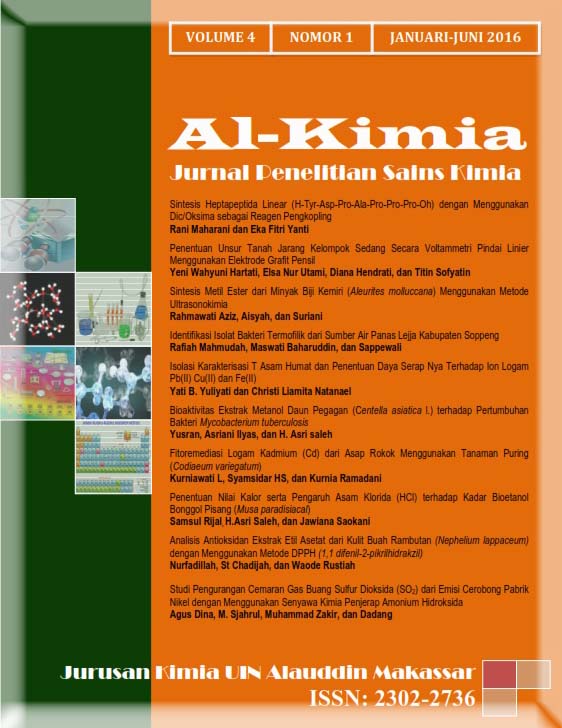Isolasi Karakterisasi T Asam Humat dan Penentuan Daya Serap Nya Terhadap Ion Logam Pb(II) Cu(II) dan Fe(II)
Abstrak
Coal, which are decomposition resulted of natural biological processes over the years in which the humic acid compound contained. The purposes of this research was tocharacterize and to compare the humic acid of coal from South Borneo. The isolation of humic acid by leaching process uses natrium karbonat 0.1 N and fractionation uses sulfuric acid 6M. The fraction was purified and the deposit was washed by sulfuric acid 1 M, aquadest and ethanol. Moisture content, ash content, cation exchange capacity, C/N ratio and E4/E6ratiowithspectroscopy were characterized. The yields of humic acid areobtained 12.35% of coal. C/N ratio of humic acid 20.72. The infrared spectroscopy results of humic acid from coal figures more of aromatic and -OH group with lower E4/E6 ratio, while from peat soil shows more of aliphatic and carboxylic group supported higher E4/E6 ratio. Kapasitas tukar kation 640,59 mek/100g; dan mempunyai daya serap terhadap ion logam yang cukup baik.##plugins.generic.usageStats.downloads##
Referensi
Aiken, G.R., McKnight, D.M., Wershaw, R.I., and MacCarthy, P., 1985, Humic Substances in Soil, Sediment and Water : Geochemistry, Isolation, and Characterization, John Wiley & Sons, New York.
Alimin, Narsito, Sri Juari S, dan Sri Noegrohati. 2005. Fraksinasi Asam Humat dan Pengaruhya pada Kelarutan Ion Logam Seng (II) dan Kadmium (II) : Jurnal Ilmu dasar. 6/1 :1-9.
Chen,Y., Senesi,N., & Schnitzer, M. (1997). Information Provided on Humic Substances by E4/E6 Rations. Soil Sci.Am.J.,41(41), 352-358.
Korodi Gyula. 2011. Application of humic acids and their derivatives in environmental pollution control. Hungary; Journal of AARMS. 11, No. 1 (2012), 61–65.
Prasasti, D. Juari, S. Sudiono, S. 2012, Studi Kapasitas Adsorpsi-Reduksi ion Au(III) Pada Asam Humat Hasil Isolasi Dari Tanah Gambut Rawa Pening : Jurnal Ilmiah Kefarmasian. 2/2 : 141-151.
Shirshova, L.T., Ghabbour, E.A., & Davies, G.(2006). Spectroscopic Characterization of Humic Acid Fractions Isolated From Soil Using Different Extraction Procedure.Geoderma, 133(3–4), 204-217.
Tatzber, M., Stemmer, M.,Spiegel, H.,Katzlberger, C., Haberhauer, G., Mentler, A., & Gerzabek, M.H. (2007).FTIR-spectroscopic characterization of humic acids and humin fractions obtained by advanced NaOH, Na4P2O7, and Na2CO3 extraction procedures.Journal of Plant Nutrition and Soil Science,Volume 170, Issue 4, pages 522–529.
Stevenson, F.S. (1994). Humus Chemistry; Genesis, Composition, Reactions. Interscience Publication. John Willey & Sons, Inc New York.
Sudarmadji, S. Bambang H, Suhardi. 2007. Analisis Bahan Makanan dan Pertanian. Libberly. Yogyakarta.
Tan, K.H. (1992). Prinsiple of Soil Chemistry. Marcel Decker, Inc. Newyork.
Yong R and Cynthia A. 2006. Humic acid preparation, properties and interactions with metals lead and cadmium. Canada; Journal of Engineering Geology, 85, 26–32.
##submission.copyrightStatement##
##submission.license.cc.by-nc-sa4.footer##Authors who publish with this journal agree to the following terms:
1) Authors retain copyright and grant the journal right of first publication with the work simultaneously licensed under a Creative Commons Attribution License that allows others to share the work with an acknowledgement of the work's authorship and initial publication in this journal.
2) Authors are able to enter into separate, additional contractual arrangements for the non-exclusive distribution of the journal's published version of the work (e.g., post it to an institutional repository or publish it in a book), with an acknowledgement of its initial publication in this journal.
3)Authors are permitted and encouraged to post their work online (e.g., in institutional repositories or on their website) prior to and during the submission process, as it can lead to productive exchanges, as well as earlier and greater citation of published work (See The Effect of Open Access).


